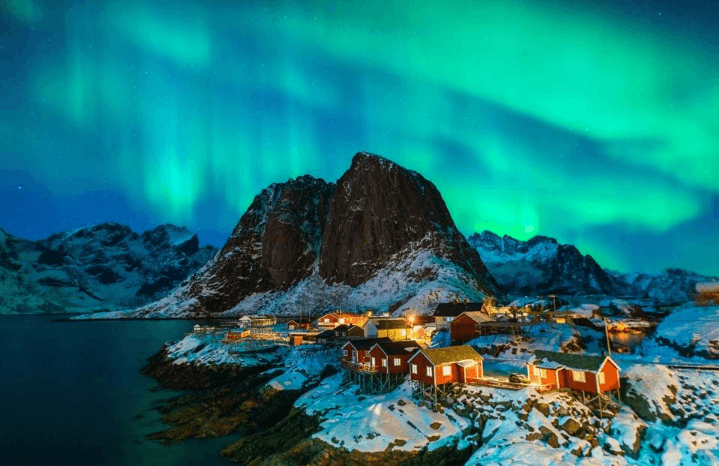
Northern Lights: A Geomagnetic Storm Could Illuminate the Skies Over Parts of the U.S. Tonight…
The Northern Lights, or Aurora Borealis, are a natural spectacle of ethereal beauty, often associated with the far reaches of the polar regions. However, this week, sky watchers in parts of the U.S. may be in for a rare treat as geomagnetic conditions could bring the Northern Lights to states much farther south than usual. Thanks to a coronal mass ejection (CME) from the sun, which is expected to reach Earth, the auroras might be visible as far south as northern states like Michigan, Minnesota, and even parts of New York on the night of November 6, 2024. This event follows an M3.8-class solar flare, a medium-sized eruption of energy on the Sun’s surface that has triggered the disturbance in Earth’s magnetosphere.
What Are the Northern Lights?
The Northern Lights, scientifically known as the Aurora Borealis, are a result of the interaction between the solar wind—charged particles emitted by the Sun—and Earth’s magnetic field. When these charged particles collide with gases in Earth’s atmosphere, such as oxygen and nitrogen, they release energy in the form of light. This light is visible to the human eye as colorful ribbons or arcs in the sky, typically in shades of green, pink, red, purple, and sometimes even blue.
While the Northern Lights are most commonly observed in high-latitude regions near the Arctic, particularly in countries like Norway, Sweden, Finland, and Canada, solar activity can extend the auroral zone, occasionally bringing the auroras much farther south.
What Is a Coronal Mass Ejection?
A coronal mass ejection (CME) is a massive burst of solar wind and magnetic fields rising from the Sun’s corona (its outermost layer). This event occurs when a large amount of plasma and magnetic fields are ejected into space. When these charged particles reach Earth, they interact with our planet’s magnetic field, causing disturbances in the geomagnetic environment. The result can be geomagnetic storms, which can produce the stunning auroral displays seen in the night sky.
Solar flares and CMEs are part of the Sun’s natural activity cycle. The Sun goes through an approximately 11-year cycle of increasing and decreasing solar activity, and we are currently in Solar Cycle 25, which began in 2019. As the Sun moves toward its solar maximum, expected in 2025, solar flares and CMEs are expected to increase in frequency and intensity, leading to more frequent geomagnetic storms.
Solar Flare and CME: What Happened?
On November 4, 2024, a significant solar flare classified as M3.8 was detected. Solar flares are categorized into classes based on their intensity, with M-class flares being medium-sized. Though not the most intense category (which would be X-class), M-class flares are still capable of affecting Earth’s magnetosphere and producing auroral displays. The flare was followed by a CME, which, in this case, is expected to reach Earth’s magnetic field around November 6, 2024.
The combination of this M-class flare and the resulting CME has created conditions that could lead to heightened geomagnetic activity. This means that on the evening of November 6, residents of several U.S. states may be able to witness the Northern Lights, a rare occurrence for many who live far from the Arctic Circle.
Where Will the Northern Lights Be Visible Tonight?
According to space weather experts, the geomagnetic storm caused by the CME could push the auroral oval an area where auroras are typically visible further south than usual. This means that people in parts of the U.S. could have a chance to see the Northern Lights tonight.
The best locations to see the auroras will be in the northern latitudes, where the geomagnetic storm will be most intense. These states include:
Michigan (especially the Upper Peninsula)
Minnesota
Wisconsin
North Dakota
Montana
New York (especially upstate)
Maine
New Hampshire
In some cases, the aurora may be visible as far south as Illinois, Iowa, Indiana, and even parts of Ohio
In addition to northern states, areas located at higher altitudes or near clear skies away from city lights may have the best chance of seeing the auroras. The further north you are, the better your chances of catching the light show, but if you live in one of the states listed above, it’s worth taking a look at the sky, especially after dark.
When and How to See the Northern Lights
The auroras typically appear after sunset, around 9:00 p.m. local time, and can continue throughout the night, often peaking around midnight. However, it’s important to keep in mind that auroras are not a guarantee. They depend on the level of geomagnetic activity, which can fluctuate. So even though conditions appear favorable, seeing the Northern Lights will depend on factors such as cloud cover, light pollution, and your location within the auroral zone.
Here are a few tips for maximizing your chances of seeing the aurora:
1. Get as far north as possible: The further north you are, the better your chances of seeing the aurora. If you’re in a state near the Canadian border, head to a location with an unobstructed view to the north.
2. Choose a dark location: Avoid city lights and artificial light pollution. The darker the skies, the better you will be able to see the auroras.
3. Check the weather: Clear skies are essential for observing the aurora. Cloud cover can block the light display, so check your local forecast before heading out.
4. Be patient: Aurora displays can be faint or sporadic, so be prepared to wait. The best displays can sometimes last for hours, but shorter bursts of activity are also common.
Why Are Geomagnetic Storms Important?
Geomagnetic storms can have wide-ranging effects beyond just creating beautiful auroral displays. While they are largely harmless to humans on the ground, geomagnetic storms can interfere with satellite communications, GPS systems, and power grids. Strong solar storms have been known to cause power outages, especially in areas with weaker magnetic fields. The 1989 geomagnetic storm in Canada, for example, caused a widespread power outage in Quebec.
In addition to their effects on technology, geomagnetic storms also play a role in space weather forecasting. As humanity becomes more reliant on satellite communications, navigation systems, and space-based technology, understanding space weather phenomena like solar flares and CMEs is increasingly important.
Conclusion
On the night of November 6, 2024, sky watchers in parts of the U.S. will have a rare opportunity to witness one of nature’s most stunning spectacles the Northern Lights. This rare event is the result of a powerful CME triggered by an M3.8 solar flare, which is expected to induce a geomagnetic storm capable of bringing the auroras as far south as parts of the U.S. northern states.
If you’re in an area with clear skies, away from artificial light pollution, take a moment to look up. You may be fortunate enough to see the mesmerizing colors of the aurora dance across the night sky a reminder of the Sun’s powerful influence on our planet, even from 93 million miles away.






